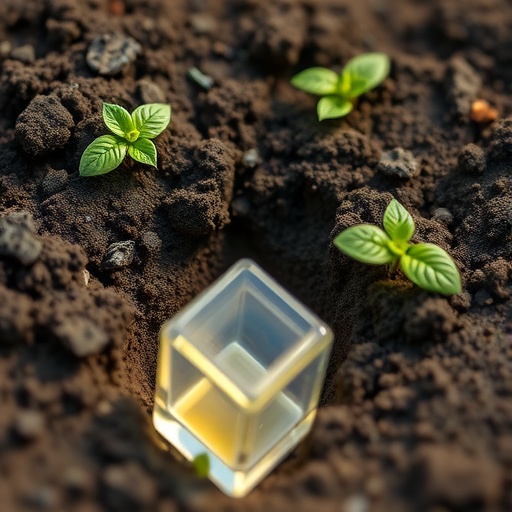In an era where environmental contamination by microplastics has evolved into a pressing global crisis, groundbreaking research unveiled by Teggers, Heck, Meisterjahn, and colleagues introduces a transformative approach to extracting synthetic microplastics from soil matrices. Published recently in Microplastics & Nanoplastics, this study presents a modified oil extraction technique designed to isolate both pristine and weathered synthetic polyurea microcapsules alongside polyethylene microplastics from complex soil environments. The implications of this research echo across environmental science, methodology innovation, and pollution mitigation, promising refined analytical accuracy and enhanced remediation protocols.
Microplastic pollution, encompassing a range of synthetic polymer particles often measuring less than five millimeters, has infiltrated ecosystems worldwide, with soils acting as significant reservoirs. The challenge for researchers has been the reliable extraction and quantification of these minuscule pollutants amidst heterogeneous soil compositions. Prior techniques historically feature chemical digestion or density separation, yet they struggle with efficiency, selectivity, and sometimes alter the physical integrity of particles, especially those subjected to environmental weathering. This new method endeavors to overcome these barriers by exploiting oil-based extraction principles, which harmonize with the hydrophobic nature of many plastic polymers.
The study’s core innovation lies in its modification of existing oil extraction methodologies, tailored specifically for the nuanced recovery of synthetic polyurea microcapsules—a type of microplastic less studied compared to more ubiquitous forms like polyethylene—and polyethylene particles. By adapting the oil type, extraction duration, and agitation protocols, the authors optimized microplastic retrieval without inducing degradation or introducing contaminants that might confound subsequent analyses. This balance between recovery yield and preservation offers a vital advancement in sample integrity crucial for downstream characterization techniques.
Throughout the comprehensive experimental trials, the team systematically compared the efficiency of their modified oil extraction method against conventional procedures across multiple soil types, including agricultural, forest, and urban soils. Weathered microplastics, which undergo physicochemical transformations such as surface oxidation, fragmentation, and biofilm formation, were included to mimic realistic environmental scenarios. Remarkably, the technique demonstrated superior recovery rates for both fresh and environmentally aged particles, suggesting its robustness and versatility under diverse environmental conditions.
A significant portion of the research delves into the physicochemical interactions between hydrophobic oil phases and polymer surfaces, illuminated through advanced imaging and spectroscopic analyses. The affinity of oil molecules for plastic surfaces facilitates the detachment of particles from mineral matrices by reducing adhesion forces. This mechanistic insight not only rationalizes the extraction efficiency but also guides further refinements that could optimize selectivity for various polymer types, broadening the method’s applicability.
Moreover, the research highlights the method’s compatibility with downstream analytical platforms, such as micro-Raman spectroscopy, Fourier-transform infrared spectroscopy (FTIR), and scanning electron microscopy (SEM). The gentle nature of oil extraction preserves particle morphology and surface chemistry, critical parameters for authentic environmental fate assessments and toxicological studies. This synergy between extraction and analysis represents a holistic advancement in microplastic research workflows.
Beyond laboratory settings, the potential applications of this approach extend to environmental monitoring programs aiming for accurate quantification of soil microplastic burdens. Policies and remediation strategies depend heavily on data reliability; thus, methods that improve extraction consistency underpin effective decision-making. The modified oil extraction could become a benchmark protocol, facilitating comparability among studies and contributing to the establishment of global standards for soil microplastic analysis.
The implications also resonate in agroecology, where microplastics in soils threaten soil health, plant growth, and food safety. By enabling the detailed study of microplastic distributions and transformations in agricultural soils, the method can guide mitigation measures and inform safer agricultural practices. Additionally, its sensitivity to weathered particles enhances understanding of long-term environmental impacts and degradation pathways of plastics in terrestrial ecosystems.
Teggers and collaborators acknowledge certain limitations and propose avenues for future work, such as scaling the technique for large-volume soil samples and testing with a broader spectrum of polymer types, including emerging synthetic compounds. They also suggest integrating this method with bioassays to couple physical extraction with biological impact assessments, offering holistic insights into the ecological ramifications of microplastics.
The study stands as a testament to interdisciplinary collaboration, blending environmental chemistry, materials science, and soil ecology, capturing the complexity of plastic pollution challenges. Demonstrating a refined approach with tangible advances lays a foundation for enhanced environmental stewardship and supports the global community’s efforts to counteract pervasive plastic contamination.
This research not only enriches the technical toolbox of environmental scientists but also signals a pivotal step toward unraveling the intricate behaviors of microplastics in soils and mitigating their ecological footprints. As environmental crises related to microplastics escalate, innovative and reliable methodologies such as this modified oil extraction technique become indispensable in forging effective responses.
By addressing both pristine microplastics and those subjected to environmental weathering, the study reflects a comprehensive perspective that mirrors real-world scenarios where plastics undergo dynamic transformations. This realism boosts the ecological relevance and applicability of findings, thus providing policymakers and practitioners with more meaningful data to drive interventions.
In conclusion, the modified oil extraction technique represents a leap forward in microplastic research, enhancing the precision, efficiency, and applicability of soil microplastic extraction. It stands poised to become an instrumental method for scientists seeking to understand and combat the pervasive infiltration of microplastics into terrestrial ecosystems. The work of Teggers and team embodies the innovative spirit essential for confronting one of the most challenging environmental issues of our time.
Subject of Research: Modified methods for extracting synthetic microplastics from soil, focusing on both pristine and weathered particles, including polyurea microcapsules and polyethylene microplastics.
Article Title: Modified oil extraction of pristine and weathered synthetic polyurea microcapsules and polyethylene microplastics from soil.
Article References: Teggers, EM., Heck, S., Meisterjahn, B. et al. Modified oil extraction of pristine and weathered synthetic polyurea microcapsules and polyethylene microplastics from soil. Microplastics & Nanoplastics 5, 21 (2025). https://doi.org/10.1186/s43591-025-00121-0
Image Credits: AI Generated
DOI: https://doi.org/10.1186/s43591-025-00121-0
Tags: analytical accuracy in microplastic studieschallenges in microplastic quantificationenvironmental contamination by microplasticsenvironmental science advancements in pollution controlhydrophobic polymer extraction methodsinnovative pollution mitigation strategiesmodified oil extraction methodologyoil extraction techniques for microplasticspolyethylene microplastics isolationpolyurea microcapsules extractionsoil pollution and microplasticssynthetic microplastics in soil remediation





